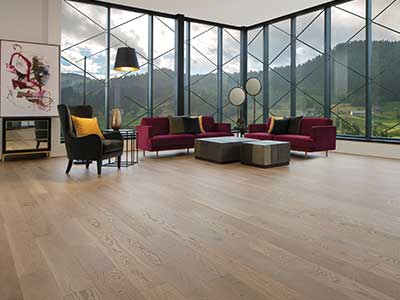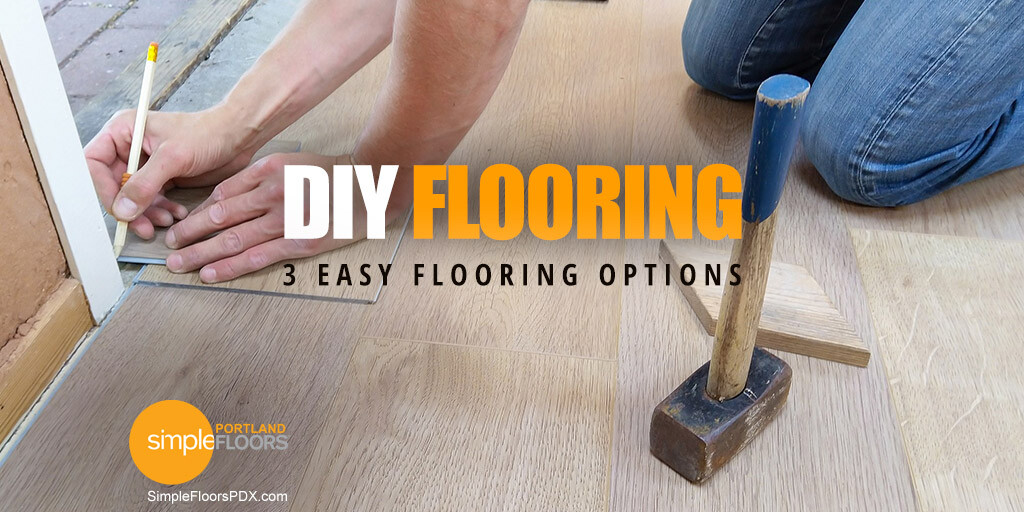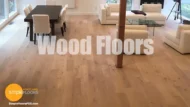You might be considering tackling a home improvement project right now. You might even be potentially stepping into unknown territory by taking on a DIY project, or you may be scratching your head, trying to determine the best type of flooring for that home renovation as well. If your project requires that A) you can manage it on your own AND B) still have your completed project look the way you had originally envisioned, then we are here for you!
Let’s discuss some ways you can choose the best floor options for your remodel with the simplest, DIY-friendly installation process. Options that leave out all the sticky, messy adhesives and awkward cumbersome tools.
What Are My Best DIY Flooring Options?
Selecting flooring that you can handle on your own during the installation is critical when you are a newbie DIYer or just infrequently grapple with the process of floor installation. First, you need to consider the location you are placing the flooring in since high traffic patterns and moisture-prone areas need different types of floor options, and you also need to understand the pros and cons of each type of flooring material. You will need to prep your subfloor after you demoed the existing flooring. This step requires making sure all protruding nails or staples are removed on the subfloor, and all the loose debris is cleaned up before moving to the installation process.
Engineered Wood Flooring –
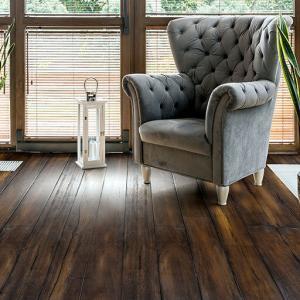 Engineered wood flooring is a composite type flooring that is made up of layers as opposed to solid material. The planks are created with layers of a top surface of prefinished selected hardwood, while the other layers are made up of various components of wood veneer. These layers create a strong flooring substrate while still offering a more affordable option than traditional solid hardwood flooring. And without the hassle of a difficult installation.
Engineered wood flooring is a composite type flooring that is made up of layers as opposed to solid material. The planks are created with layers of a top surface of prefinished selected hardwood, while the other layers are made up of various components of wood veneer. These layers create a strong flooring substrate while still offering a more affordable option than traditional solid hardwood flooring. And without the hassle of a difficult installation.
You will not need to sand, stain, or seal this product after installing it, which makes the labor piece less overwhelming and time-consuming. The best part is that you will not be encumbered with nailing or gluing during the install with most engineered products. Engineered wood flooring also has the look and appearance of real hardwood and a natural wood surface that looks identical to solid wood. It comes in prefinished planks that easily snap together with a tongue and groove like fastening. The planks float over your subfloor with a foam, rubber-like underlining. This keeps the whole installation process at a lower skill level than the installation of solid hardwood flooring, while still offering the beautiful finished appearance of warm wood floors. The wide variety of colors and wood-grain patterns are vast, so it can make even the pickiest design-conscious homeowner happy. Lastly, the only one who will know it isn’t real hardwood flooring is you!
Luxury Vinyl Flooring [LVT] –
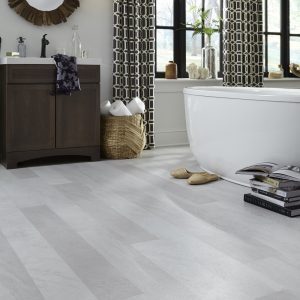 Resiliency is the hallmark of LVT, and why so many people place this in their homes today. It has been around for a while but the look and feel of this product have drastically improved over the years. Let’s just say it has become a big fave as a DIY-friendly flooring. The newest luxury vinyl flooring choices are floating sheets of vinyl that do not need to be glued down to your subfloor and require a minimum amount of tools and labor to put down. Some selections of LVT are so sturdy that you can use them simply as a feature within the center of your room, something along the lines of an area rug.
Resiliency is the hallmark of LVT, and why so many people place this in their homes today. It has been around for a while but the look and feel of this product have drastically improved over the years. Let’s just say it has become a big fave as a DIY-friendly flooring. The newest luxury vinyl flooring choices are floating sheets of vinyl that do not need to be glued down to your subfloor and require a minimum amount of tools and labor to put down. Some selections of LVT are so sturdy that you can use them simply as a feature within the center of your room, something along the lines of an area rug.
Installation of luxury vinyl flooring is a snap! Remove your molding in the room, template the floor with paper, cut the flooring to fit the template with a utility knife, and then lay the flooring down above the subfloor while keeping it snug against each tile. Finally, just replace your molding back into place and you’re ready to enjoy it for years to come. Some unique benefits of luxury vinyl floors are not just its easy installation, but also the flooring itself is more durable and lasts longer while additionally supplying a softer, more cushioned floor to walk on. If you have pets and/or an active family this flooring is ideal.
Laminate Flooring –
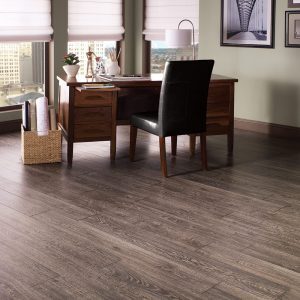 Laminate flooring is a companion option to engineered flooring in that it also is a floating floor, it is installed by a tongue-and-groove fastening system and it comes in various widths, colors, wood species. So, what is the difference? Laminate has a top surface of plastic lamination and not a wood surface like engineered wood flooring. Another difference is that the laminate flooring planks come in shorter lengths.
Laminate flooring is a companion option to engineered flooring in that it also is a floating floor, it is installed by a tongue-and-groove fastening system and it comes in various widths, colors, wood species. So, what is the difference? Laminate has a top surface of plastic lamination and not a wood surface like engineered wood flooring. Another difference is that the laminate flooring planks come in shorter lengths.
Laminate flooring has an extensive assortment of choices due to the graphic method used to create the design layer on the laminate flooring that is highly realistic. It’s printed and then glued to a core of fiberboard backed by a layer that’s treated to prevent moisture damage. Next, a final clear topcoat is applied that was developed exclusively to resist scratches and marks.
The most well-known benefit to laminate is that it is remarkably resistant to wear and tear. While the first option (engineered wood flooring) is more susceptible to stains, scratches, and fading, the laminate alternative can take a licking and keep on ticking. Some of our premium laminate brands offer a 30-year warranty. If durability is your primary concern, then this is an excellent option for you.
Check-In With Our Design Team To Get Going
 Whichever option you decide to go with discuss first with our expert design team some key aspects of your DIY project before you move forward. You will need to provide us with the location in your home where the flooring will be installed, and the square footage of that space. We can then discuss further specific requirements you may have overlooked in the planning of your project and provide our professional recommendations. We are here for you, and feel free to jump on our Simple Floors PDX Online Chat for some quick answers to your immediate questions. Let’s get to making that home project a reality!
Whichever option you decide to go with discuss first with our expert design team some key aspects of your DIY project before you move forward. You will need to provide us with the location in your home where the flooring will be installed, and the square footage of that space. We can then discuss further specific requirements you may have overlooked in the planning of your project and provide our professional recommendations. We are here for you, and feel free to jump on our Simple Floors PDX Online Chat for some quick answers to your immediate questions. Let’s get to making that home project a reality!
“All things are created twice; first mentally; then physically. The key to creativity is to begin with the end in mind, with a vision and a blueprint of the desired result.” ~ S. Covey

